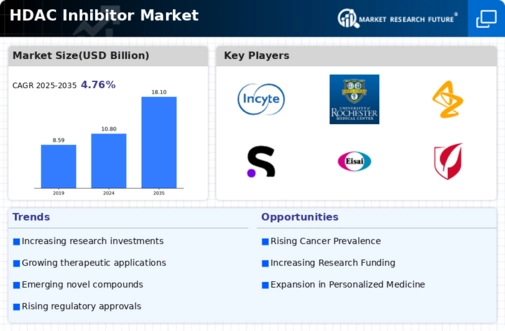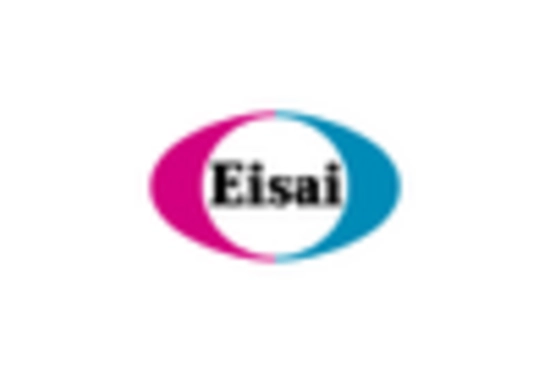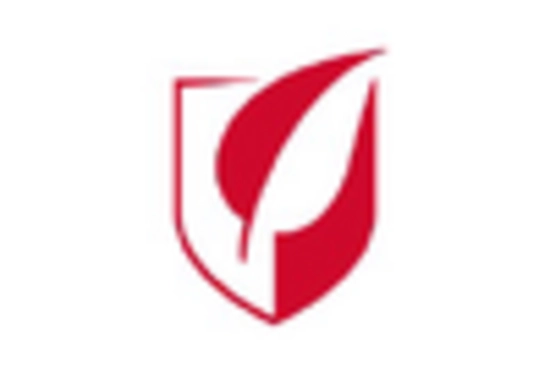Increasing Prevalence of Cancer
The rising incidence of various cancers is a pivotal driver for the HDAC Inhibitor Market. As cancer remains a leading cause of mortality worldwide, the demand for effective treatment options continues to escalate. HDAC inhibitors have shown promise in clinical trials, particularly in hematological malignancies and solid tumors. The market for HDAC inhibitors is projected to grow significantly, with estimates suggesting a compound annual growth rate (CAGR) of over 10% in the coming years. This growth is largely attributed to the increasing number of patients seeking innovative therapies that target cancer at the epigenetic level. Consequently, pharmaceutical companies are investing heavily in research and development to bring new HDAC inhibitors to market, thereby enhancing the overall landscape of the HDAC Inhibitor Market.
Rising Investment in Biotechnology
The HDAC Inhibitor Market is significantly influenced by the increasing investment in biotechnology. As governments and private entities allocate more resources towards biopharmaceutical research, the development of HDAC inhibitors is gaining momentum. This influx of funding is facilitating advanced research initiatives and clinical trials, which are essential for bringing innovative therapies to market. Recent data suggests that biotechnology investments have surged, with venture capital funding reaching unprecedented levels. This financial support is crucial for the exploration of novel HDAC inhibitors and their potential applications across various therapeutic areas. As a result, the HDAC Inhibitor Market is poised for substantial growth, driven by the convergence of scientific innovation and financial backing.
Regulatory Support for Novel Therapies
Regulatory bodies are increasingly supportive of novel therapies, including HDAC inhibitors, which is a key driver for the HDAC Inhibitor Market. Initiatives aimed at expediting the approval process for breakthrough therapies are encouraging pharmaceutical companies to invest in HDAC inhibitor development. The introduction of programs such as Fast Track and Breakthrough Therapy Designation by regulatory agencies has created a favorable environment for innovation. This regulatory support not only accelerates the time to market but also enhances the attractiveness of HDAC inhibitors as viable treatment options. Market analysis indicates that the approval of new HDAC inhibitors is likely to increase, thereby expanding the therapeutic landscape and driving growth within the HDAC Inhibitor Market.
Growing Awareness of Epigenetic Therapies
There is a burgeoning awareness of epigenetic therapies, which is significantly impacting the HDAC Inhibitor Market. As healthcare professionals and patients become more informed about the role of epigenetics in disease progression, the demand for HDAC inhibitors is likely to rise. Educational initiatives and scientific publications are contributing to this awareness, highlighting the potential of HDAC inhibitors in treating various conditions beyond cancer. Market trends suggest that as understanding deepens, the acceptance of these therapies will grow, leading to increased prescriptions and utilization. This shift in perception is expected to bolster the HDAC Inhibitor Market, as more stakeholders recognize the therapeutic benefits of targeting epigenetic mechanisms.
Expanding Applications in Neurological Disorders
The HDAC Inhibitor Market is witnessing a notable expansion in the treatment of neurological disorders. Conditions such as Alzheimer's disease and Huntington's disease are increasingly being targeted by HDAC inhibitors, which have demonstrated potential in preclinical studies. The growing understanding of the role of epigenetics in neurodegenerative diseases has spurred interest in these therapies. Market data indicates that the segment for neurological applications is expected to grow at a CAGR of approximately 8% over the next few years. This trend reflects a broader shift towards personalized medicine, where HDAC inhibitors may offer tailored treatment options for patients with specific genetic profiles. As research continues to unveil the mechanisms of action, the HDAC Inhibitor Market is likely to see a surge in product development aimed at addressing these complex disorders.

















Leave a Comment